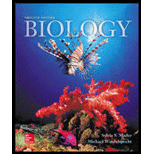
Concept explainers
How may a pedigree pattern be used to determine if a disease is autosomal dominant or autosomal recessive?
To determine:
How pedigree pattern can be used to determine whether a disease is autosomal dominant or autosomal recessive.
Introduction:
Pedigree determines the biological relationship between an individual with their family or ancestors by using the standard symbols. The pedigree is important to predict as it helps in determining the dominant or recessive inheritance pattern of the traits and the genetic disorders related to it.
Explanation of Solution
Pedigree analysis theoretically determine about the transmission pattern of a genetic disease from one generation to the other. A disorder could be in autosomal dominant, autosomal recessive and X linked dominant or recessive conditions.
The characteristics of autosomal dominant traits are:
• The one affected parent can produce affected progeny. In autosomal dominant inheritance, the trait will occur in every generation.
• The affected number of male and females are roughly equal.
• In autosomal dominant the expression of a trait does not depend on the gender of an individual.
• Each affected parent may not produce affected offspring as they could be carrier of the dominant disorder.
• The probability of inheriting the disease by each offspring from both affected parents is 0.5.
The characteristics of autosomal recessive traits are:
• In autosomal recessive, the trait will not occur in every generation.
• The affected number of male and female are not equal.
• Both normal parents could produce affected offspring as they could be carrier of the affected allele.
• The probability of inheritance of disease by one out of every four offspring is 0.25.
With the help of above characteristic, it is easy to use pedigree analysis used to determine whether a disease is autosomal dominant or autosomal recessive.
Depending upon the characteristics of dominant and recessive disorders, the transmission of a disorder could be predicted through pedigree.
Want to see more full solutions like this?
Chapter 11 Solutions
Biology
- What is behavioral adaptarrow_forward22. Which of the following mutant proteins is expected to have a dominant negative effect when over- expressed in normal cells? a. mutant PI3-kinase that lacks the SH2 domain but retains the kinase function b. mutant Grb2 protein that cannot bind to RTK c. mutant RTK that lacks the extracellular domain d. mutant PDK that has the PH domain but lost the kinase function e. all of the abovearrow_forwardWhat is the label ?arrow_forward
- Can you described the image? Can you explain the question as well their answer and how to get to an answer to an problem like this?arrow_forwardglg 112 mid unit assignment Identifying melting processesarrow_forwardGive only the mode of inheritance consistent with all three pedigrees and only two reasons that support this, nothing more, (it shouldn't take too long)arrow_forward
- Oarrow_forwardDescribe the principle of homeostasis.arrow_forwardExplain how the hormones of the glands listed below travel around the body to target organs and tissues : Pituitary gland Hypothalamus Thyroid Parathyroid Adrenal Pineal Pancreas(islets of langerhans) Gonads (testes and ovaries) Placentaarrow_forward

 Human Biology (MindTap Course List)BiologyISBN:9781305112100Author:Cecie Starr, Beverly McMillanPublisher:Cengage Learning
Human Biology (MindTap Course List)BiologyISBN:9781305112100Author:Cecie Starr, Beverly McMillanPublisher:Cengage Learning Human Heredity: Principles and Issues (MindTap Co...BiologyISBN:9781305251052Author:Michael CummingsPublisher:Cengage Learning
Human Heredity: Principles and Issues (MindTap Co...BiologyISBN:9781305251052Author:Michael CummingsPublisher:Cengage Learning Biology (MindTap Course List)BiologyISBN:9781337392938Author:Eldra Solomon, Charles Martin, Diana W. Martin, Linda R. BergPublisher:Cengage Learning
Biology (MindTap Course List)BiologyISBN:9781337392938Author:Eldra Solomon, Charles Martin, Diana W. Martin, Linda R. BergPublisher:Cengage Learning Concepts of BiologyBiologyISBN:9781938168116Author:Samantha Fowler, Rebecca Roush, James WisePublisher:OpenStax College
Concepts of BiologyBiologyISBN:9781938168116Author:Samantha Fowler, Rebecca Roush, James WisePublisher:OpenStax College





